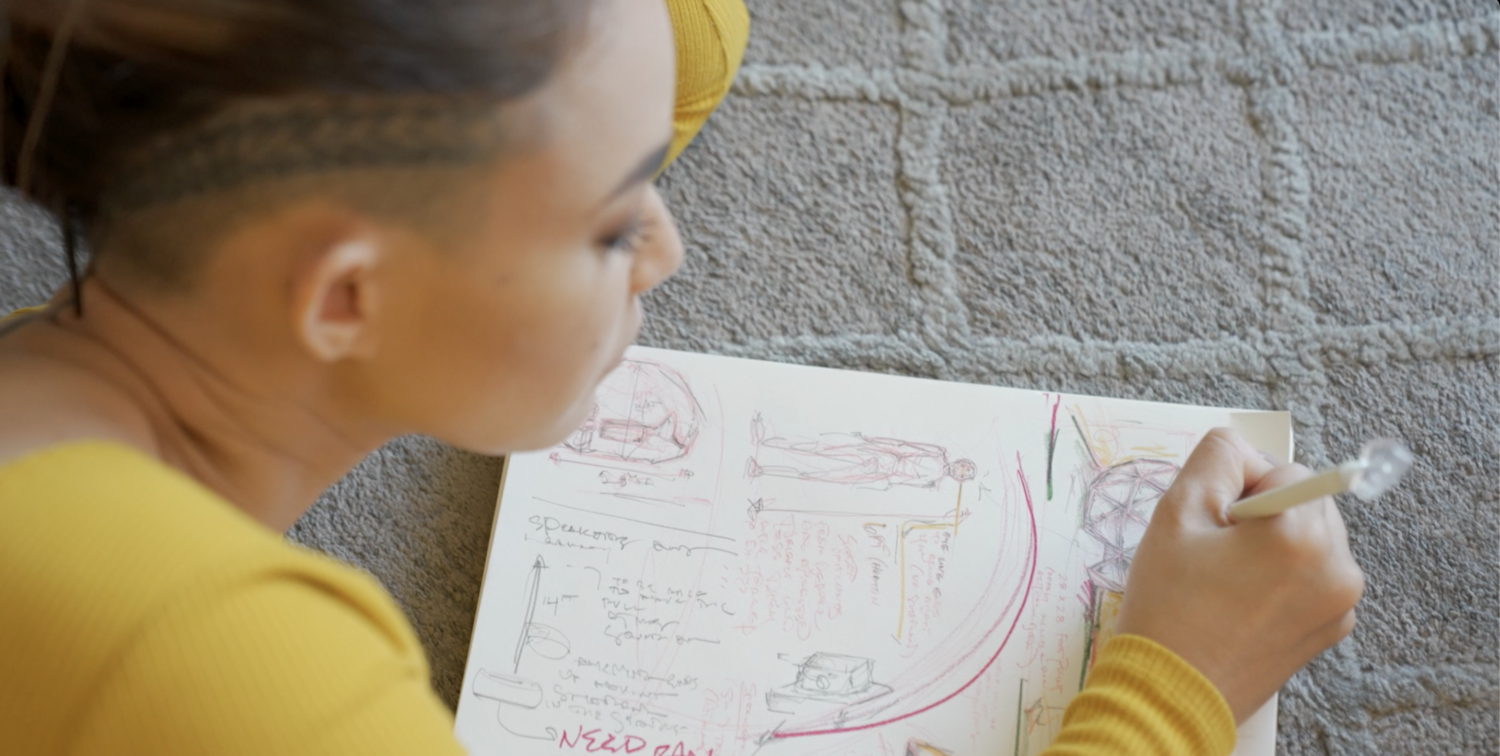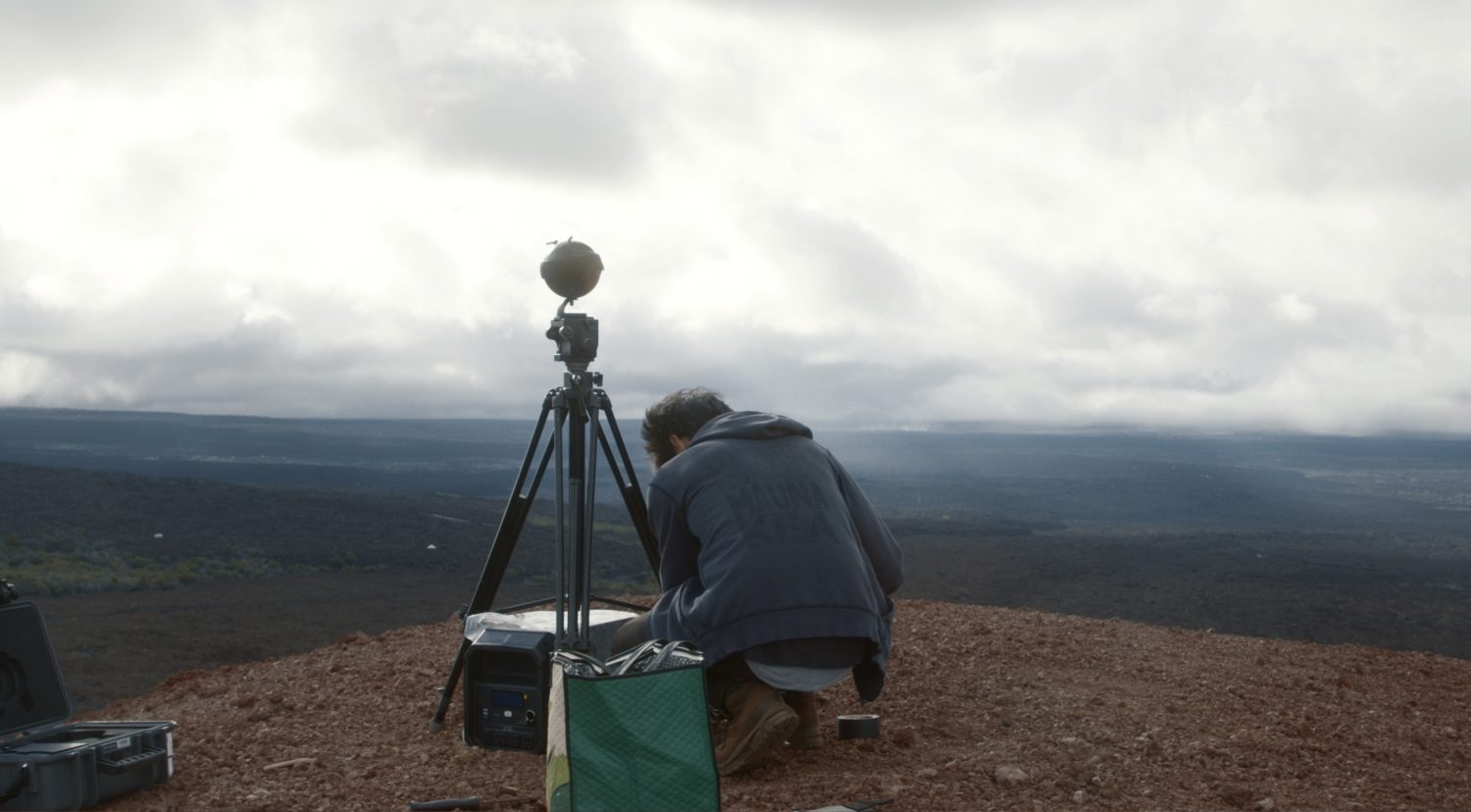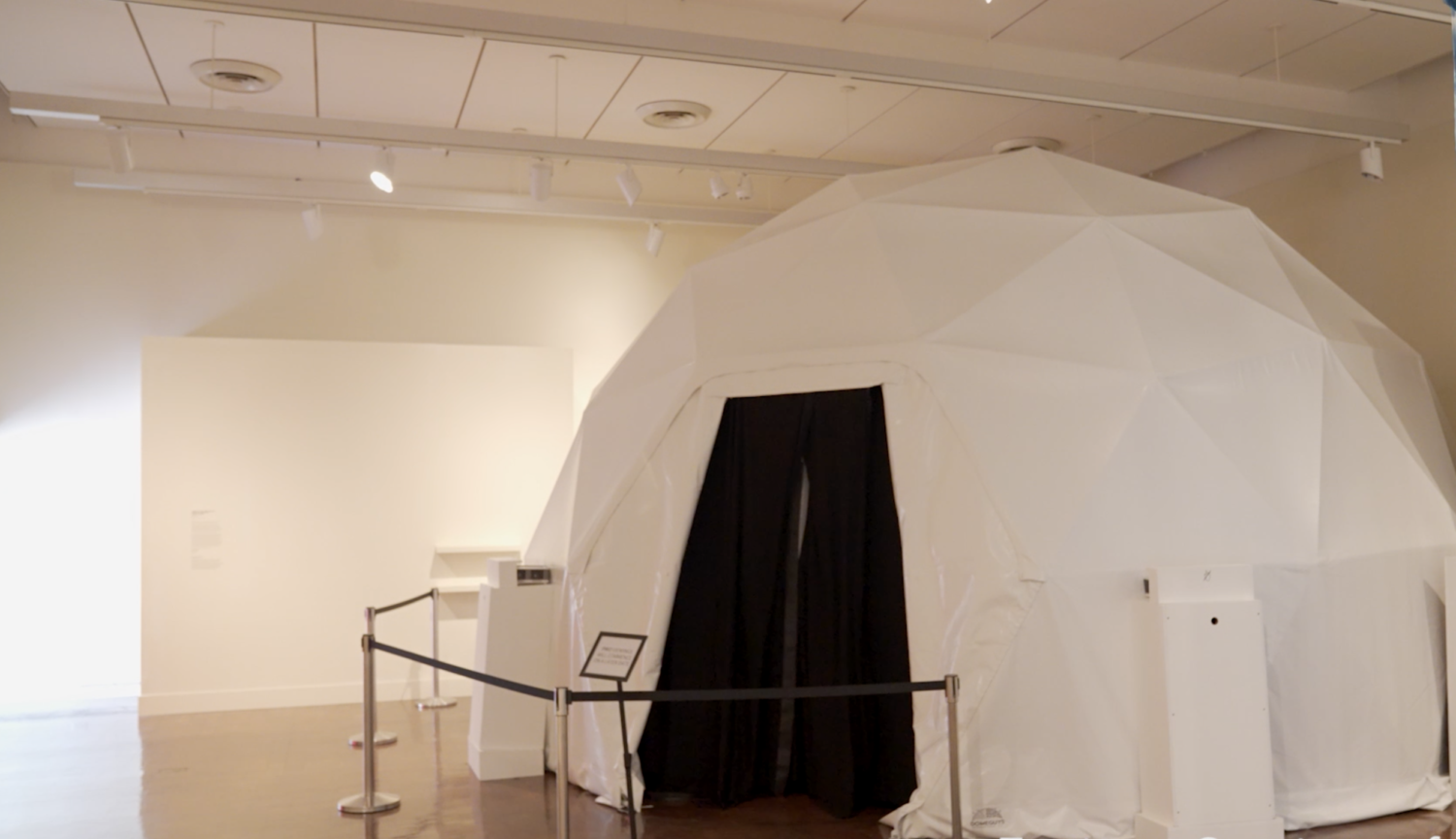Kānaka Maoli artists Christopher Kahunahana, Lanakila Mangauil and Nicole Naone construct an immersive, tech-forward framing in which to ruminate on the question of sacredness: a 360-degree virtual reality experience manifested from the piko of Hawai‘i Island.
A preliminary sketch for a video piece had been brewing in the filmmaker Christopher Kahunahana’s mind all while on Maunakea in the summer of 2019. Along with Nicole Naone, a Honolulu-based sculptor who works in communications and was Kahunahana’s producer on the independent feature Waikiki, the two longtime collaborators had been supporting kia‘i (protectors) on the mauna as part of Puʻuhonua o Puʻuhuluhulu’s cohort of media-makers from across the islands, who were working together to manage the narrative surrounding the Thirty Meter Telescope protests through frontline videos and call to actions posted across social media.

But when Covid-19 struck in March 2020, temporarily curtailing all mass gatherings on both sides of the issue around the mauna—Native Hawaiians and scientists alike—Kahunahana had an opportunity, like many involved, to step back and reflect on the experience. Finally, the unformed Maunakea film that had been percolating began to take significant shape.
The result became PIKO, an artistic effort between himself, Naone, and Lanakila Mangauil, a kumu hula who successfully disrupted the groundbreaking ceremony for the TMT in 2014. On view through January 16, 2022, PIKO is part of this year’s Artists of Hawaiʻi Now exhibition at the Honolulu Museum of Art, the dome-shaped installation — provocatively reminiscent of a telescope — utilizes state-of-the-art virtual reality technology to blur the spaces between science and sacredness, the self and the environment.
Presenting two years of time-lapse footage shot in 6K on an Insta360 Pro, which utilizes a spherical VR lens, at more than 8,000 feet above sea level on Hawai‘i Island, the site allowed simultaneous filming of Maunakea, Maunaloa and Hualālai’s land and skyscapes for the first time. Paired with booming Hawaiian chants by Mangauil, all recorded in Atmos, the piece forwards both an explicit political thrust and a soulful metaphysical message to right-size another misleading narrative that pertains to Native Hawaiians over the community’s embrace of various fields of science and tech. Flux Hawaii spoke with the three artists about the genesis of the project, art as a means of protest, and mirroring the transcendence of the mauna through virtual reality.

On Embodying Piko
Nicole Naone We’re a great representation of three piko: past, present, future. Chris is a great representation of the future because he’s the one pushing this technology forward, having this idea for PIKO, taking on this really daunting insane task of figuring out how to pull it off, projecting himself into the future and getting the technology to catch up even.
Lanakila is the kūpuna piko, representing all of those connections that go all the way to creation, all the way to pō. He’s that complete understanding of the full-on, uninterrupted connection of Hawaiians who know all of the signs, stops, twists, and turns — how to track it all the way to the beginning.
I am the present piko. I’m between past and future figuring out how to make both exist in the now—and for right now.
Chris Kahunahana Being from Hawai‘i Island, Lanakila brought his personal connection to the mauna. Although I have the respect and basic understandings of the mauna, I didn’t have that personal relationship with the mountain. Because what we were trying to capture was something that’s below the surface, not just the top layer — the piece is not a geography lesson. Lanakila brought what was needed which is that deeper understanding.
I’ve never been in an art show before, this is my first art show ever. Nicole brought that professional artist’s sensibility and knows how to navigate these museum environments, working with curators. Also, her talents as a producer. She also brought her Big Island connection to the mauna, too.
NN I love seeing us in this way because it’s not age-specific, not gender-specific — it’s a concept-specific way of showing what we all brought to the table for this piece and reflects our own essences. Everybody brought magic.
On Virtual Reality
NN In terms of the piece’s scale, the underlying kaona is that the technology we’re using is advanced: A lot of its use is reactionary to people saying about the demonstrations on the mauna, “Look, it’s these ancient Hawaiians again who don’t care about science, who just want to live in grass shacks, grumbling about science at Maunakea.” It was important to us to really get rid of that narrative because it’s incorrect.
CK With the VR, I liked engaging with the aspect of how science is studied on the mountain, on the mauna: They only look up. We wanted to capture the makawalu view, which is you got to see everything, right? You have to see, past, present, future, and in every direction. That was a huge part of it.
NN There are definitely some interesting connections there. So much of this piece is centered around perspective shifts, and in a literal sense. Literally: Stop only looking up. Look around. These call to actions are literal and they are real.
Lanakila Mangauil In creating the VR image, to me, we’re recreating the goal of why we have ritual. In the rituals, in the ceremonies, with the prayers, the goal is to lele, to transcend into this space, which so many of our people don’t engage with anymore, so they have no concept of what it is, what it “looks” like. So, this piece is kind of creating a scenario where that goal is met. The first time I watched the VR, I was like, There it is, that is the ultimate manifestation, that sense of being right on the mauna and observing all of it, yet we’re not there. When you look down [in the VR footage], you don’t see your feet or your hands. For me, that image is the true, full, natural state of sacredness. It’s not even because of Hawaiians that the mountain is sacred; Hawaiians are important because of our connection to the sacred mountain. But remove the human presence, the mountain is what breathes life into everything. We’re here now because of the mountain. We come, we go, the mountain is still giving that life.
In our absence we saw what the goal is for Maunakea, and many other Hawaiian places, which is the natural healing of the environment that started taking place.
Lanakila Mangauil
That’s the powerful thing about this technology and helping to support, to give this opportunity to the masses who are losing touch with these abilities that ritual and ceremony gives us access to, a kind of, I guess, manufactured lele or feeling of transcendence. Using that particular “prayer tech” to reach that transcendence, to see that image, to feel that likeness, you know, it’s almost like being a ghost. It’s like, I’m there, but I’m not there. That’s like the whole point of transcendence, to be able to leave your physical body and be able to know hua lele—you’re observing this plane and seeing the bigger, broader picture without actually physically having to be there. Without having to move this, haul that, in order to be in a place. That’s a reminder too of why it’s important that these places be protected. For us to just be in these places because we want to go, we make an impact.
NN Part of what makes the VR so transcendent in this context is the sound, the oli. In contemporary VR scenes, when you’re transported to a beautiful location it’s for entertainment and the music supports that, it’ll be a light song or an exciting score. Our piece, which is made with an indigenous lens, we’re trying to create a past-present-future portrait of the space. Therefore, the sound also adds to that transcendence. The recorded sounds are of the actual wind from the mauna, the actual rain. Those recordings are real.
CK It was super important to us to have the oli broadcasted in the physical space. It couldn’t just be in the headphones, it had to be in the actual space, it has to be separated from the experience of being in the VR headset. Something about the sound playing out the way it does moves the air and changes the energy within the space. That’s an ancient magic.
LM There’s only one chant [included in the piece] that’s specifically of Maunakea. I also chose some well-known oli like Ha Mele No Kāne and Kumulipo—there are so many different creation chants, so many different water chants. Again, it’s also about hearing these chants and prayers in their intended function of ritualization, of being put into the ceremony. These chants, they’re not all describing the specifics of Maunakea necessarily, but the natural cycles of our environment and universe. They’re getting to the cellular level. For instance, Ha Mele No Kāne, is about the movement of water. When we’re chanting these things, the oli are affecting those same elements within those that hear them. That’s why it’s so important to highlight that in this way. Oli are not just some ambient thing—these are the words that were given to Hawaiians by this environment. How even our language is because of the sounds of this place and that we’ve mimicked those sounds into words.

Kahunahana at Pu‘ukohe. 
Exterior of PIKO at Honolulu Museum of Art.
On Activist Art
NN The beautiful part about the piece is that the people who are protecting Maunakea, who already know the sacredness, they feel it. But, for me, personally, the piece absolutely is for pro-TMT-ers because they need to switch their perspective. The people whose opinions haven’t shifted, even after seeing the thousands of people up there protecting the mountain, even after seeing the report about telescopes leaking coolant. That’s absolutely my perspective, at least from me being the present piko, right? I’m like, those are the people that I need to talk to now. Like, there are people that still aren’t getting it yet.
LM For me, Maunakea is, first and foremost, an environmental movement. It’s about the ‘āina. We are necessary because of the ‘āina. That land is what gave us our identity as Hawaiians, it’s not the other way around. We didn’t make the mountain sacred; the mountain is sacred and gives us life. As Hawaiians, we are the ones who absolutely know that, who intimately understand the process and the cycles of how we’re sustained by this ‘āina, and therefore our culture, our existence. What gives us, in part, our right to be indigenous to this place is because we’re part of that indigenous ecosystem.
CK There was always the awareness that the projection dome would look like a telescope. We can’t take away the shape of the dome, but to a certain extent that’s also just the shape that is necessary for a project that has a projection component like this. I knew a lot of people were excited about that aspect of it, like that it would be interpreted that way. But honestly, in the formation of the idea, for me, personally, the piece is like a love song between us Kānaka and the mauna. So, initially when you encounter the piece it feels like we’re speaking directly to the pro-TMT audience, but gestation wise, it wasn’t that. For a lot of people the first time they even thought about the mauna was because of the protests, as a place of confrontation with Hawaiians. But for me, with this piece, I want to just tell the mauna that I love her. To embrace her — that’s what I wanted the piece to feel like.
NN That’s the switch that I’m talking about, especially for pro-TMT-ers. We didn’t make a didactic piece, it’s a feelings piece, it’s communicating to souls and it’s communicating to emotion and it’s communicating love. And that’s the thing that gets portrayed in PIKO. Because again, like I said, with pro-TMT-ers, they already know all the factual stuff and that didn’t cause a change in their minds. So, let’s portray our love for a space, and the sacredness and the genealogy of the space.

On Absence and Presence
LM We can have our respective targets and our hopes of what people will take away from the piece, but that’s the beauty of PIKO and the makawalu, the multiple interpretations, of it. I see it as a great teaching tool, even for Kānaka — this is just another means to help us to continue enriching and deepening that learning.
I feel it gives for many Kanaka, and even non-Kanaka who support the mountain, that never had a chance to come to the mountain a way to go there, so to speak. Even people who just saw everything that was happening in the media with the movement and are curious. This now creates a lens or an opportunity for them to also step into it.
The big lesson of the piece, to me, is about when you are being absent, yet, you’re present. Your absence is your presence. Because, ultimately, regarding the piko of the mountain that’s the actual traditional practice by Hawaiians: We stayed the hell off the mountain. We only went up for the most absolutely important reasons. And even then, it was like, “Get up, hurry up and get the hell out.” Don’t leave a footprint. Don’t make a mark. So, it’s not even about us as Hawaiians just trying to stake our claim, or plant our flag, no, no, no, no, no. Then we just becoming like them. We’re not doing this to occupy that space. We’ve had to occupy out of necessity in order to protect it. But the goal is that as soon as we remove the threat, then we out, so the ‘āina can do its thing.
That’s the continued teaching for me, for Kānaka, and for humans in general. What the mauna movement displays and can be echoed, I think, in many other movements around environmental issues across the world over all kinds of mountains and natural environments that sustain our lives and are being threatened in different ways. People are missing the connection that it’s not about, “Oh, we have to have control it, we have to do this.” It’s really about letting these places be because they’re our life force.
CK The pandemic gave us more time. I think it got refined. If we had less time—it was initially supposed to go up in 2020—it would have been a different piece, for sure. For instance, one of the first shoots that we did was the transition from Lono to Kū. We shot footage of a ceremony at the ahu celebrating the changing of the season. So, originally, we considered having humans in it, but I think it got so much better because we couldn’t have humans in it anymore because of Covid. That goes back to what Lanakila was saying about no people. We found how to convey the sacredness of the piece.
LM This has been my makawalu prayer with Covid which was a big eye-opener. It silenced everybody. Everybody. All parties in this arena and many other arenas—Covid sent everybody back to our rooms to think about what we’ve done. And in our absence we saw what the goal is for Maunakea, and many other Hawaiian places, which is the natural healing of the environment that started taking place elsewhere. That is our goal.
This interview has been edited for length and clarity.



